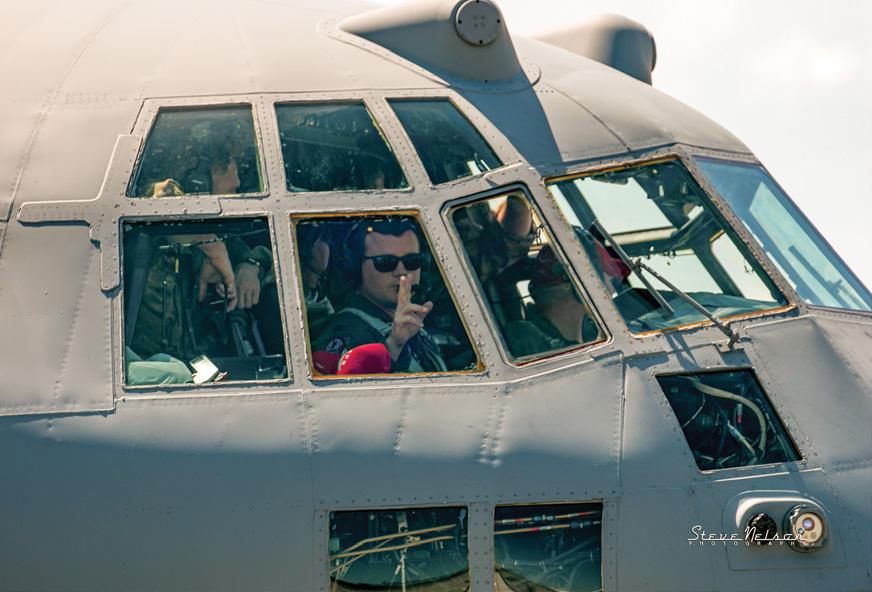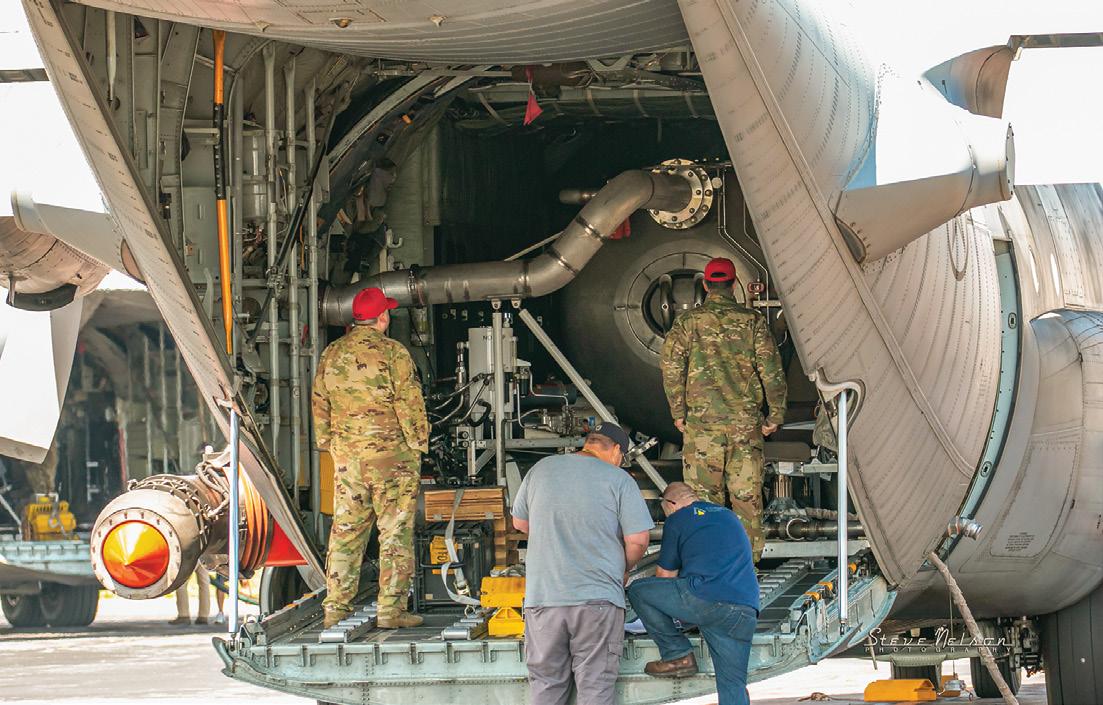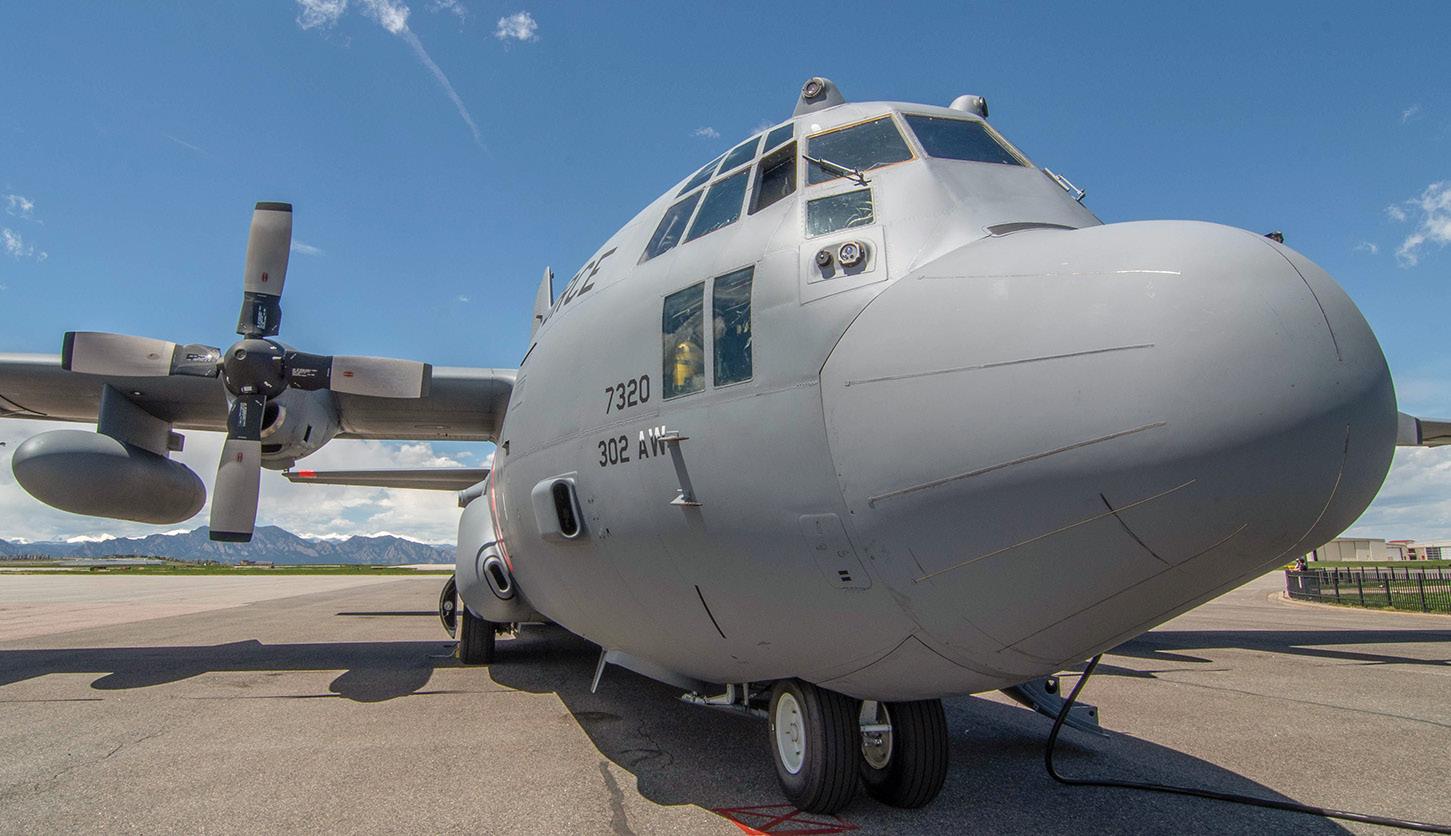
12 minute read
MILE-HIGH MAFFS
Story by Ryan Mason Photos by Steve Nelson, Ryan Mason, USAF Public Affairs
The C-130s descended on Rocky Mountain Metro Airport in Colorado for this year’s annual MAFFS training event held over the first week of May.

May of 2021 saw Broomfield, Colorado’s Rocky Mountain Metro Airport receive an influx of C-130’s from the Wyoming Air National Guard and the Air Force MAFFS unit based in Colorado Springs.


Above: A MAFFS C-130 drops a practice load approximately 45 minutes outside of Denver.
Inset: Training was conducted with the assistance of the USFS Jeffco Tanker Base located at Rocky Mountain Metro Airport. Each aircraft participating in the annual training event is equipped with the USDA Forest Service’s Modular Airborne Fire Fighting System (MAFFS.) The program is a joint effort between the U.S. Forest Service and the Department of Defense. Four C-130 wings support the MAFFS mission, including three Air National Guard units: Nevada’s 152nd Airlift Wing, California’s 146th Airlift Wing, and Wyoming’s 153rd Airlift Wing; and one U.S. Air Force Reserve unit, Colorado’s 302nd Airlift Wing.
Annual USDA Forest Service-led MAFFS training operations are typically coordinated as a joint operation between Colorado, Wyoming, Nevada, and California. As COVID protocols complicated the planning and execution of yearly training, the military decided to split the training. One week of training was conducted at the McClellan USFS firebase at the USFS firebase at Rocky Mountain Metro Airport.
Rocky Mountain Metro Airport sits just outside the Denver metro area. Thanks to its use as a US Forest Service tanker base, it made for the perfect location for the second week of MAFFS training attended by the U.S. Air Force Reserve and Air National Guard. Pilots and loadmasters assigned to the 302nd and 153rd Airlift Wing descended on Rocky Mountain Metro Airport, using the airports FBO as their base of operations to execute classroom training and plan each day’s drop of potable water over several National Forests within flying distance of Rocky Mountain Metro.

The USFS Jeffco Firebase at Rocky Mountain Metro acted as the operational fire control base for filling the aircraft MAFFS tanks after each evolution. The primary purpose of the week of ➤
Inset: A pilot of one of the C-130s signals a successful training mission on arrival back to the Jeffco Tanker Base before refilling.
Below: One of the littlest fans of the C-130 looks on as an aircraft arrives at the Rocky Mountain Metro FBO for a crew change. training was for pilots, loadmasters, other crew members and support personnel assigned to each unit to gain certification with the U.S. Department of Agriculture Forest Service for the 2021 wildland firefighting season.
Col. Gary Monroe, of the Wyoming National Guard, who is this year’s 153 Air Expeditionary Group commander, First Air Force (Air Forces Northern) stated that as a functional MAFFS team, “the wider operation consists of eight MAFFS units from four wings in the California Air National Guard, Nevada Air National Guard, Wyoming Air National Guard, and the Colorado Air Force Reserve. Each of the four Wings have MAFFS capable aircraft and two MAFFS units, so up to eight planes could be activated at a time if needed in a real-world environment. We can deploy as many aircraft as needed up to the eight anywhere the USFS needs our help. .”
From Training to Real World
The military contingent of aerial firefighters is typically requested by the National Interagency Fire Center (NIFC) based on incident severity and aircraft availability, said Col. Monroe. The aircraft will be requested through DOD channels by NIFC and deployed as soon as they can be equipped (typically within 48 hours) and headed to the fireground with a full contingent of staffing that includes pilots, maintenance personnel, and other flight, and other logistics and ground personnel.
Typical deployments for a MAFFS unit are 30 days at the minimum. According to Monroe, “they’ll try to request assistance for thirty days because it’s easier to get us going and keep us ready. Administratively, it’s easier for them to ➤



Above: The C-130 is a versatile platform that can be transformed from a workhorse multi mission aircraft into an aerial tanker with the installation of the MAFFS system that allows it to drop retardant across large swaths of terrain.
Inset: Crews have meticulously detailed every drop the aircraft has made on a fire on the side of the MAFFS tank inside the belly of the C-130. cut us off early if the need goes away or to extend us if they need us longer.” Once crews are in place, each team will fly for seven-day increments and then rotate out due to military flight rules and regulations. This allows for a constant service level to be in place for the duration of a fire with aircraft always available and not leaving an aircraft on the ground due to rest time requirements.
Although the MAFFS units typically respond within the western U.S., their deployments can be anywhere.. Col. Monroe stated that MAFFS teams have been sent to incidents all over the U.S. and even Mexico, and Indonesia.
Practice Makes Perfect
In addition to gaining annual qualifications through the United States Forest Service, Monroe states that he also values the training for all staff involved in the training, allowing for more in-depth training to take place both on the ground and in the air. “The training gives us the experience, not only within our organizations, but working with our agency partners, such as the Forest Service. Getting to know them, talking one on one, hearing them on the radio, and then putting our pilots into training scenarios where they can gain experience and confidence, so when they’re on a fire, when there are helicopters and smoke and a lot of radio chatter, they’re confident and comfortable in that environment, and safe. I mean, practice makes perfect. Safety is always the key,” said Monroe.

Training Challenges
While training is an essential piece of the pie, Monroe stated that there are still differences between the simulated roles in annual training and those that occur during a real-world firefighting operation. “If you are going out into a training environment, you don’t have the smoke, and you don’t have the fire. Radio chatter in training can ➤


Above Left: USFS crews worked seamlessly alongside the military crew members to ensure fast turn around during training.
Above Right: Air Force and National Guard crew members worked rapidly during training to ensure aircraft spent minimal time out of service during the week of training.
Right: Over 100 military members were on site at Rocky Mountain Metro Airport during the weeks training. be slower and less busy than you would see for a real fire, so those can be some of the biggest challenges.”
Qualifications
Only the best of the best can join the MAFFS teams, according to Monroe. However, he considers the National Guard to be quite lucky. Many of the pilots who join are typically older and already serve in a flying role in their day-today jobs, some being very high-time commercial pilots. However, when it comes to the MAFFS operation, pilots still have to put their time in on the C-130 airframe, needing to log 750 hours as a co-pilot and 1500 hours on type for consideration as a pilot in command for MAFFS operations.
Keeping it all Running
Managing a training event with four aircraft and over 150 personnel can be a daunting task at the best of times. Still, Monroe and his other command staff from both the National Guard and the Air Force Reserve take the operation in stride, doing their best to keep the training operation running smoothly. One of the most ➤


Above: Crew members work tirelessly throughout the day to ensure that crews have everything they need for each mission and monitor the MAFFS equipment on board the aircraft.
Inset: The cockpit of the aircraft typically contains a pilot, co-pilot and navigator and can at times include a training officer for competency flights. significant considerations that cannot be planned for its weather, which did impact operations and delay training due to rain for a day during the training operation, but Monroe stated that each team works tirelessly to ensure everything is in constant working order. Still, there will always be curveballs that no one can plan for.
During the training, one of the aircraft briefly paused from flying for a maintenance issue, but thanks to the dedication of maintenance crews, the aircraft was back and functional the same day, able to continue training.
Executing Training
Executing a training operation such as the mission conducted in Colorado in May is something that doesn’t just begin once the crews arrive in Colorado; Major Laura Jeffrey, Wyoming Air National Guard, was the mission commander for the training.
The training mission for Jeffrey and her crews starts back in Wyoming so that teams can hit the ground running when they arrive. “Our job before arrival is to get the MAFFS tanks loaded onto the aircraft and test them before leaving for training or an actual fire mission. The MAFFS tanks are owned and maintained by the Forest Service, so if we have any issues once we arrive, we have their maintainers who can assist us. They’ll work on them on our behalf, and then we get the mission done. Once we are complete with our training or with a real fire season, we’ll offload the MAFFS tank from the aircraft, then the only time that they get reloaded is if we get activated on a fire,” said Jeffrey.



Above: Colorado’s Rocky Mountain Metro Airport and the surrounding terrain offer challenges not found at airports in lower altitudes and give the air crews the challenge of working in a hot and high environment, much like a fire would be.
Left: MAFFS tanker one returns to the Jeffco Fire Base after a training flight.

Safety Factors
One of the main concerns of a large-scale training operation is to make sure all military staff are safe. This has taken on a new level this year with all staff having to don COVID-19 masks during the training and other safety precautions.
In the aircraft, safety revolves around many factors; flying safely can mean taking on less of a retardant load based on the density altitude, the crew load, outside air temperature, and many other factors daily and can vary from flight to flight, especially in the higher altitudes like Colorado. “We start to look at all those things and determine what the best type of load we can take is, or the amount of fuel that we have to go out and conduct our mission; what makes this mission very different from other missions is the altitudes that we fly, we’re in mountainous terrain, and we’re constrained. So when you mix those two things, you limit what an aircraft can do capability-wise. When you’re trying to climb out, you have to consider performance; you’ll also look at what the terrain is like. Are you doing a drop where you need to fly out really quick? Or do you have a valley you can go down to try to gain some speed and to try to get some energy so that you can ➤

Above: The C-130’s spent a week at Rocky Mountain Metro Airport while other units conducted training in California due to Covid protocols.
Below: Each C-130 on site required a small army of maintaners and crew to keep each aircraft in top shape during training operations. get out of there? So there’s a lot of different moving pieces, and it’s never the same. So you could be dropping on the same fire all day long, and it is the same dynamic. It’s never the same constraints,” said Jeffrey.
Staffing the Aircraft
Each MAFFS C-130 during training is typically staffed with a crew of six, two pilots, a flight engineer, a navigator, and two loadmasters. During training, the aircraft can also have instructors in each of those positions, teaching those individuals how to do the job. The crew onboard for training operations never exceeds ten people in the aircraft. On an actual fire, staffing is limited to the six essential roles and one additional instructor if required.
Training Take-Aways
The National Guard and the Air Force have learned many lessons from the MAFFS missions and continue to apply new lessons learned in training and real-world applications. During this training, one of the many things noticed was each crew’s ability to talk over issues and devise safer and better ways to do what they do daily. Maj. Jeffrey noted crews are encouraged to talk out missions and discuss any concerns at length as a group to promote safe practices.

“When we do our ground training, all the units are usually together, except this year due to COVID-19. Part of our training is to talk about years past and situations or incidents that we came across. We like to talk about those particular incidents and say, Oh, this was a situation that we had, what was your thought process for this? We can talk about it as professionals, and then we can talk about ways to mitigate situations that keep us safer. And sharing that information with all four of our Wing’s makes us better aviators at the end of the day. We learn from one another, and you can take the experiences of others and apply them to your practices.”
On to Fire Season
This year’s training evolution had its complexities, like having to split training into two separate training evolutions into two different locations due to COVID; it is clear that this annual training is not only beneficial to the military branches that participate but to the state and federal partners that also play a part in the more comprehensive MAFFS operation that will no doubt be called into action this fire season and for many to come.






